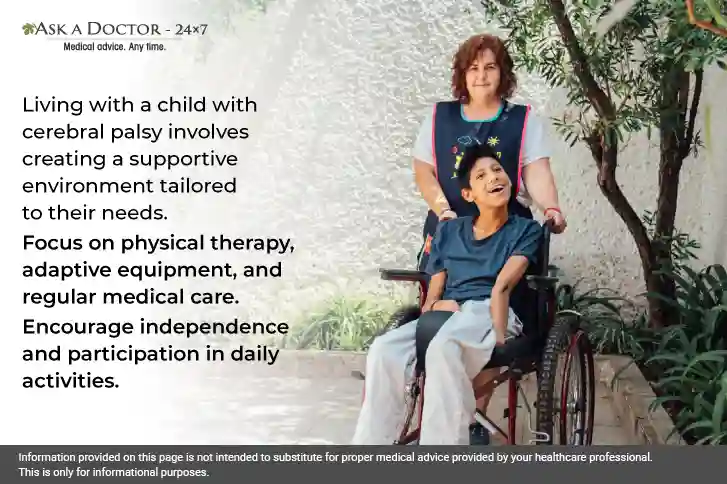All About Cerebral Palsy
Cerebral Palsy (CP) is a group of neurological disorders that impair the muscles' coordination, tone, posture, and movement. It occurs when the brain cannot communicate with muscles in a way that allows for smooth and coordinated movement. Other bodily processes that rely on motor abilities and muscles, such as eating, talking, breathing, and bladder and bowel control, can also be impacted by CP.
Cerebral palsy is the result of damage to your brain during fetal development or any developmental disability that affects the way your brain develops. The symptoms may vary from person to person and do not get worse over time. Although there isn't a cure for cerebral palsy, however, patients can live better lives with the proper treatment, therapy, or assistive devices. Let’s understand this neurological disorder in detail.
What Causes Cerebral Palsy?

CP is caused by abnormalities or injuries of the brain. Most of the cases occur when the baby is growing in the womb. But they can happen anytime during the first 2 years of life, while the baby's brain is still developing. In a few cases, the cause of CP is never determined. The main causes are:
- Preterm birth
- Infections in the spinal cord or brain, such as bacterial meningitis or viral encephalitis
- Events that prevent blood flow to the brain (such as strokes), obstructive oxygen flow to the brain (like in difficult birth), or near-drowning events
- Untreated jaundice
- Physical abuse
- Unmanaged or low blood sugar level
- Heavy metal ingestion (like lead or mercury)
Symptoms of Cerebral Palsy
Cerebral palsy symptoms are typically not noticeable right after birth. They usually begin to stand out at a young age. Everybody who has CP struggles with posture and mobility. The kind and intensity of CP symptoms vary from person to person and might even alter over time.
Cerebral palsy can affect mobility, ability to talk, and outward appearance. The common symptoms include:
- Early feeding difficulties
- Delays in reaching developmental milestones (like not sitting by 8 months or not walking by 18 months)
- Poor motor (muscle) control, i.e. unable to crawl, walk, or move arms or legs
- Muscle spasms or contractions
- Shaking hands (tremors) or other jerky movements that can’t be controlled
- Stiffness in arms or legs
- Poor coordination and lack of balance
- Lack of muscle tone, giving body parts a “floppy appearance”
- Trouble walking
- Trouble with fine motor skills like buttoning clothes or tying shoelaces.
- Trouble speaking or delays in speech development
How Cerebral Palsy Affects the Body?
The four primary categories of cerebral palsy are based on the body components that are affected:
Quadriplegia: It is characterized by weakness in all four limbs, (both arms and both legs) as well as possible weakness in the torso, facial, and oral muscles.
Triplegia: In this condition, three limbs are affected, for example when both legs and one arm cannot move freely.
Diplegia: This condition affects all four limbs, with the legs more severely affected than the arms.
Hemiplegia: It is a condition affecting one entire side of the body, including the arms, legs, and trunk.
Paraplegia: It affects both legs, but not the arms.
Treatment of Cerebral Palsy
There's no cure for cerebral palsy. Yet, therapies and resources can support children's growth and development to the fullest extent possible.
Following a diagnosis of cerebral palsy, a child can start therapy for their movement and other areas that require assistance, including learning, speech, hearing, and social and emotional development. A lot of children may require assistive devices like wheelchairs or braces.
Children with severe muscle pain and stiffness may benefit from medication. A child’s pediatrician can also prescribe some medicines for seizures if required.
Self and home care include:
- Maintaining a healthy diet and weight
- Keeping the home safe
- Doing exercises as directed by healthcare professionals
- Maintaining regular bowel habits by using stool softeners, drinking fiber and laxatives
- Guarding the joint injury.
Cerebral palsy is not a disease and is not hereditary. It is caused by damage to the brain. It consists of a range of disorders relating to mobility and posture. Cerebral palsy is not a disease and is not hereditary. It is caused by damage to the brain. If your child is diagnosed CP, the pediatrician can help you understand the condition and will provide guidance and support. Also, children with CP can live longer, more fulfilled lives thanks to advancements in assistive technology.
If you have any questions related to cerebral palsy, you can check with our Pediatrician at Ask a Doctor, 24x7.
Recently Answered Queries Related to Cerebral Palsy
- What Causes Cerebral Palsy In Adult?
- Can Seroquel, Valium, Cogentin, Urecholine, And Prilosec Be Taken Together?
- Suggest Treatment For Cerebral Palsy
- Is Cerebral Palsy Curable By Ayurveda Treatment?
- Lower Motor Neuron Lesion Occur Congenitally And Result In Cerebral Palsy
- Good Appetite But Skinny Bone, Is It Cerebral Palsy?
- Is It Good To Have Stem Cell Treatment For Cerebral Palsy?
Disclaimer: Information provided on this page is not intended to substitute for proper medical advice provided by your healthcare professional. This is only for informational purposes.
Ask a Specialist
Recent Questions


